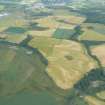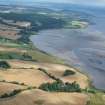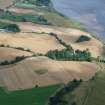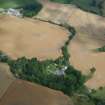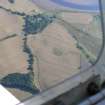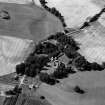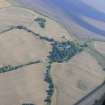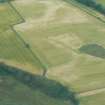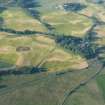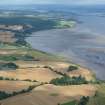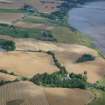Tarradale House
Plantation Bank (Period Unassigned)
Site Name Tarradale House
Classification Plantation Bank (Period Unassigned)
Canmore ID 145901
Site Number NH54NW 122
NGR NH 5489 4888
Datum OSGB36 - NGR
Permalink http://canmore.org.uk/site/145901
- Council Highland
- Parish Urray (Ross And Cromarty)
- Former Region Highland
- Former District Ross And Cromarty
- Former County Ross And Cromarty
NH54NW 122 5489 4888
Oblique aerial photographs (RCAHMSAP 1995) have recorded a plantation bank, 400m NW of Tarrasdale House (NH54NE 28). It is sub-rectangular and measures about 80m E-W by 50m transversely. The plantation bank is depicted on the current edition of the 1:10 000 map (1988) and it is situated in a field amongst a number of archaeological features (see NH54NW 23, NH54NW 24, NH54NW 25 ).
Information from RCAHMS (KJ) 14 June 1999.
Field Visit (2012)
NH 54 48, NH 54 49, NH 55 48 and NH 55 49 The Tarradale Archaeological Project (an approved NOSAS project) aims to investigate, record and interpret the multi-period archaeological landscape of the Tarradale area and to identify the main periods of settlement and resource utilisation. Tarradale was formerly a parish itself, covering about 750ha of land at the W end of the Black Isle and immediately E of Muir of Ord. The area currently being studied consists of raised estuarine beaches underlying flat, high quality, agricultural land. Apart from the medieval Gilchrist Chapel and a small area of irregular mounds, few standing or surface archaeological monuments survive in an area that is intensively ploughed, although aerial photographs show cropmarks that can be interpreted as ring ditches, pits and enclosures, with one concentration of ring and square ditches suggesting the presence of a Late Iron Age/Early Historic barrow cemetery. This contrasts with the more upland pastoral and wooded landscape where there are standing monuments including chambered cairns, one of which is the Tarradale chambered cairn.
Fieldwalking in the fields to the E and W of Tarradale House early in 2012 produced 237 lithic finds, mainly flint and many of them of microlithic size. The density of finds in relation to the area covered is low and most of the lithic finds are very small and difficult to see in a soil that is derived from coarse sand and pebbles. It appears that quartz and quartzite were also being used for artefact manufacture, probably due to the shortage of flint which does not occur naturally in the area. The project steering group decided that intensive fieldwalking should be undertaken by parallel traverses spaced 1m apart, with individual lithic, early pottery and metalwork find sites plotted using GPS. This essentially meant that all the surface area was being visually scanned for artefact survival.
The majority of the lithic finds can be classified as debitage, but there are a number of reworked flakes, end scrapers and side scrapers. An analysis of their distribution has led to the preliminary identification of a number of potential ‘hot spots’. Lithic finds also included a few larger flakes as well as a tanged and barbed arrowhead, and a number of stone spindle whorls. The lithic finds have not yet undergone detailed analysis. Supervised metal detecting of the ploughsoil revealed the broken off cutting edge of a Late Bronze Age socketed axe and a lead spindle whorl.
Fieldwalking and controlled metal detecting has also provided a picture of a general background noise of medieval pottery and a few medieval coins (for example a silver short cross penny of King Henry III of England, issued 1216–47). However, fieldwalking finds from part of one field (centred on NH 554 487) showed a well defined concentration of degraded pottery sherds, animal bone food waste and iron nails which may indicate the lost location of the former medieval Tarradale Castle that was destroyed by Robert Bruce in 1308. Supervised metal detecting of the ploughsoil in the supposed castle area produced a Henry III long cross penny and a medieval heraldic horse pendant.
Ploughing by the tenant farmer in November 2011 in the field immediately W of Tarradale House (centred on NH 548 487) brought to the surface a dense spread of marine shells, including whole oyster, cockle, mussel, whelk and periwinkle shells, as well as a mass of crushed shells. Two smaller surface spreads of shells were noted close by in an adjacent field. Given that harrowing would destroy the surface evidence, test pitting was carried out in November 2011 to attempt to assess the nature and extent and possible age of these deposits. The test pits provided incontrovertible evidence that there was good preservation of an extensive shell layer below the ploughsoil, though suffering continual degradation due to ploughing. A series of small augur boreholes was sunk to try and delimit the shell layer which was found potentially to cover 500m² and in places is up to 400mm thick and contains many millions of shells. Analysis of a sample of these shells (all of which can be found in the Beauly Firth today) shows a considerable size variation, particularly for periwinkles, with the presence of some tiny periwinkles suggesting that these molluscs were collected by bulk methods. Some of the test pits also produced pieces of antler and bone as well as spreads of charcoal within the shell layer, suggesting that it is a humanly created shell midden rather than a natural deposit of shells. The project is actively seeking funding for radiocarbon dating of these organic deposits to provide an initial chronological parameter for the site.
Archive: Highland HER, local library and RCAHMS (intended)
Funder: NOSAS – in kind
Eric Grant, Tarradale Archaeological Project, 2012
(Source: DES)
































































